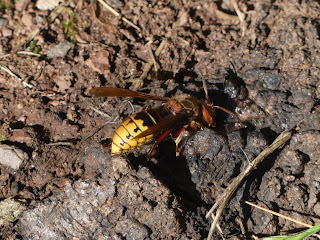European Hornet
Here's someone I haven't posted about [1], an invasive insect called the European Hornet. If you're into wasps, these gals - as eusocial insects, probably every one I've ever seen was a female - are cool to look at. The rich blackish-red on most of the front of the abdomen contrasts well with the golden-yellow at the back, and they're actually big enough for you to actually see this without lens. Of course, if you've been stung, you might classify them as scary rather than good looking [2].
They are thought to have been introduced to the US (presumably accidentally) in the 1840s, and over the last 180 years they've spread throughout most of the eastern US. And they're probably not done spreading.
Did you know that North America has zero native hornets? Anything you see over here named "hornet" is either:
- Invasive, like the European Hornet.
- Slightly misnamed, like the Bald-faced Hornet, which is actually an aerial yellowjacket. (Admittedly the yellowjackets are close relatives to the hornets.)
I saw this hornet and several other insects foraging on/near wet spots on a tree. I had assumed that was from either tree sap or maybe honeydew from Spotted Lanternflies, but a dogwalker said one of the apartment dwellers tended to dump cooking oil out there. Whatever it was, it certainly got the attention of the local wasps and butterflies.
I've had people tell me that they've seen Asian Giant (don't call us Murder) Hornets in New Jersey, but all reputable sources say that they've only been seen in Washington state and British Columbia. While those hornets may eventually become a problem over here, right now it's likely that any NJ sightings are simply misidentifications, quite possibly of the European Hornet.
Though European Hornets clearly like the fluids on the tree, they're also predatory, and will attack other insects. Although honeybees are on the European Hornet menu, AFAIK honeybees aren't attacked often enough for this to be much of a problem.
 |
| June 10, 2022 at Mt Pleasant Villas Photo 209835458, (c) jpviolette, some rights reserved (CC BY-NC) |
[1] At least not here. I used to do these posts on Tumblr, but those posts have disappeared into the ether.
[2] At a Duke Farms mothing program a few years back, something stung me. Since the European Hornet is one of the few wasps around here likely to be active at night, a European Hornet is a good candidate for having done the stinging.



Comments
Post a Comment